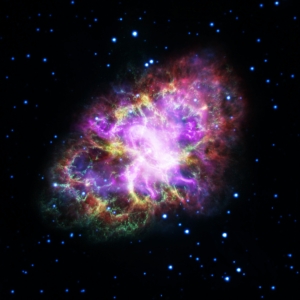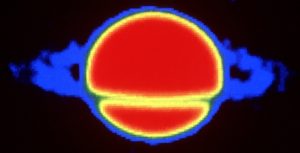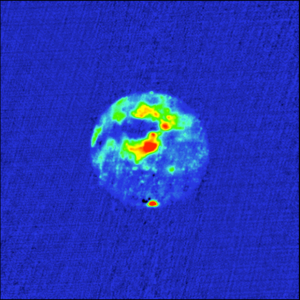Pointing the National Science Foundation’s Very Large Array (VLA) at a famous galaxy for the first time in two decades, a team of astronomers got a big surprise, finding that a bright new object had appeared near the galaxy’s core. The object, the scientists concluded, is either a very rare type of supernova explosion or, more likely, an outburst from a second supermassive black hole closely orbiting the galaxy’s primary, central supermassive black hole.


A New Look at the Crab Nebula: Individual Wavelength Thumbnails
Astronomers produced this dramatic new, highly-detailed image of the Crab Nebula by combining data from telescopes spanning nearly the entire breadth of the electromagnetic spectrum. At its center is a superdense neutron star, rotating once every 33 milliseconds, shooting out rotating lighthouse-like beams of radio waves and light — a pulsar. The nebula’s intricate shape is caused by a complex interplay of the pulsar, a fast-moving wind of particles coming from the pulsar, and material originally ejected by the supernova explosion and by the star itself before the explosion. This image combines data from five different telescopes: The VLA (radio) in red; Spitzer Space Telescope (infrared) in yellow; Hubble Space Telescope (visible) in green; XMM-Newton (ultraviolet) in blue; and Chandra X-Ray Observatory (X-ray) in purple.

A New Look at the Crab Nebula
Astronomers produced this dramatic new, highly-detailed image of the Crab Nebula by combining data from telescopes spanning nearly the entire breadth of the electromagnetic spectrum. At its center is a superdense neutron star, rotating once every 33 milliseconds, shooting out rotating lighthouse-like beams of radio waves and light — a pulsar. The nebula’s intricate shape is caused by a complex interplay of the pulsar, a fast-moving wind of particles coming from the pulsar, and material originally ejected by the supernova explosion and by the star itself before the explosion. This image combines data from five different telescopes: The VLA (radio) in red; Spitzer Space Telescope (infrared) in yellow; Hubble Space Telescope (visible) in green; XMM-Newton (ultraviolet) in blue; and Chandra X-Ray Observatory (X-ray) in purple.

Saturn in Radio Waves
This is Saturn, as seen by the Very Large Array (VLA). Note the bright disk of the planet with a gradual fading toward the edge, called limb darkening. This illustrates a gradual cooling outward in Saturn’s atmosphere. The rings are seen in emission outside the disk but then in front of the planet they absorb the radiation from the bright disk behind, appearing as a dark band. In visual light they appear bright everywhere because they reflect the incident sunlight but at radio wavelengths the sunlight is fainter and we see the actual emission from Saturn.

Radar Image of Mercury
This image of Mercury was the result of a radar experiment using the NASA JPL/DSN 70-m antenna in Goldstone, CA, as the transmitter, and the Very Large Array (VLA) as the receiver. Red areas are areas of high radar reflectivity, which can either be a result of surface and near-surface composition, or surface roughness. The north pole is the brightest region, an indication of the presence of significant amounts of water ice. A similar region has been detected at the south polar regions. The two other large reflective regions have never been photographed, so the cause of the high reflections remains a mystery.

Radar Image of Mars
This is a radar image of Mars, made with the NASA Goldstone-Very Large Array (VLA) radar system in 1988. Red areas are areas of high radar reflectivity. The south polar ice cap, at the bottom of the image, is the area of highest reflectivity. The other areas of high reflectivity are associated with the giant shield volcanoes of the Tharsis ridge. The dark area to the West of the Tharsis ridge showed no detectable radar echoes. The investigators call this region the “Stealth” region and believe it is a huge deposit of low density, volcanic ash with an absence of volume scatterers (rocks) to depths of many meters.





